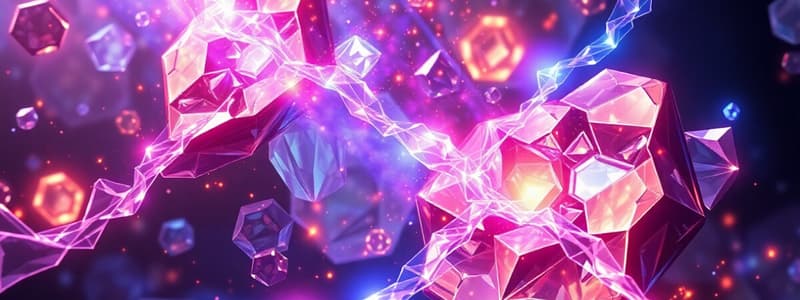Podcast
Questions and Answers
In a metallic crystal structure, what occupies every point in the crystal lattice?
In a metallic crystal structure, what occupies every point in the crystal lattice?
- Mobile valence electrons only
- Identical atoms (correct)
What are the mobile electrons in a metallic bond referred to as?
What are the mobile electrons in a metallic bond referred to as?
- Delocalized electrons (correct)
- Localized electrons
What type of attraction defines a metallic bond?
What type of attraction defines a metallic bond?
- Attraction between stationary metal atoms
- Attraction between stationary metal cations and surrounding delocalized electrons (correct)
Why do metals conduct electricity and heat well?
Why do metals conduct electricity and heat well?
What causes the luster observed in metals?
What causes the luster observed in metals?
Flashcards
Metallic bonding
Metallic bonding
A strong bond between the metal cations and the freely moving valence electrons in a metal. The cations stay fixed in a lattice, while the electrons roam freely between them.
Why metals conduct electricity?
Why metals conduct electricity?
Metals conduct electricity due to free-flowing electrons. These electrons can easily move through the metal, allowing electrical current to flow.
Why metals conduct heat?
Why metals conduct heat?
Metals are good conductors of heat because of their free-flowing electrons, which easily transfer heat energy.
Why are metals lustrous?
Why are metals lustrous?
Signup and view all the flashcards
Properties explained by metallic bonding
Properties explained by metallic bonding
Signup and view all the flashcards
Study Notes
Work Plan
- Attendance/update
- Science routines
- Review (ionic and covalent bonding)
- Discussion (metallic bonding)
- Wrap up/agreement/reminders
Chemical Bonding: Metallic Crystals
- Pure metals are crystalline solids
- Unlike ionic compounds, each point in the crystal lattice is occupied by an identical atom.
Metallic Bonding
- The electrons in the outer energy levels of a metal are mobile
- They can drift from one metal atom to another.
- Metal is viewed as an array of positive ions surrounded by a sea of mobile valence electrons (delocalized electrons)
- A metallic bond is the attraction of the stationary metal cations to the surrounding mobile electrons.
Properties of Metals
- Conduction: Metals conduct electricity and heat well due to free-flowing electrons. As electrons enter one end of a metal, an equal number flow out the other end.
- Malleability and Ductility: Metals are malleable (can be hammered into shapes) and ductile (can be rolled into thin sheets or pulled into thin wires) because the free-flowing electrons allow the metal cations to slip past one another without breaking the bond.
- Luster: When light shines on a metal its electrons absorb small amounts of energy and become excited into empty orbitals. The electrons immediately fall back to lower energy levels and emit light - this causes the high luster of metals.
Studying That Suits You
Use AI to generate personalized quizzes and flashcards to suit your learning preferences.




